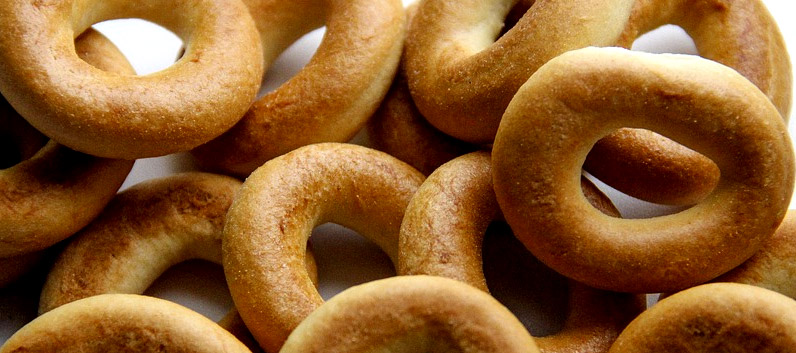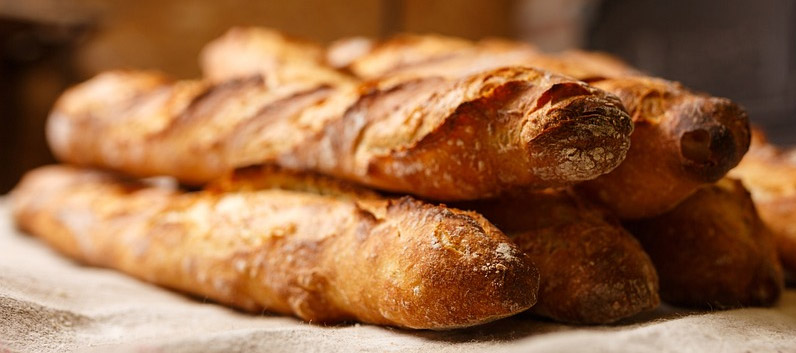In many cultures across the world, bread has always been one of the basic sources of nourishment. Usually the breads made from the flour of wheat, corn, rice, are the most popular. However, you’ll find breads made from several other grains as well. Breads are also prepared in different forms, such as flat and leavened.
All such breads have helped sustain most human cultures around the world for thousands of years. The preparation of breads involves many techniques and components. Some of the major ingredients that go into their preparation are water, flour, yeast, and salt.
Bread and wine are said to have introduced the ancient humans to the civilized life. You can have a bread as it is or with a delicious gravy prepared with vegetables or meat. Now, let’s take a look at some of the famous breads from different parts of the globe:
1. Baguette
This is a long and slender loaf with a crackly crust. The baguette has found a special place in Western pop culture mainly because of its use in films and photographs. One of the reasons behind this French bread’s popularity is that it pairs better with most foods. It has a relatively neutral flavor, which goes with almost anything that you’re served.
You can have this bread dipped into stews and soups owing to its crustiness. The baguette is also great for making sandwiches. One great example of this is ‘jambon-beurre’. It is a French sandwich made using sliced baguette filled with ham slices and salty butter.
2. Tortilla
Tortillas have nourished and nurtured the people living in Mexico and Central America for centuries. When it comes to versatility, there are very few breads that would rival it. This bread is made from a paste of ground corn. It is generally used for wrapping enchiladas and tacos.
You can turn tortillas into chips by cutting them into wedges and baking or frying them. These chips can be eaten with salsa or queso. The chips can also be used for preparing migas or chilaquiles. Fried tortillas are the foundation for dishes like flautas and tostadas.
According to some legends from the Mayan civilization, the gods created humans from a paste of ground maize or corn. The legends say that they had attempted this using wood and mud earlier, but failed. Now, this would probably make you say that tortillas are divine!
3. Paratha
Parathas are commonly eaten in most parts of the Indian subcontinent. The ancestry of this bread can be traced to ancient India. So, it won’t be fair to compare it with the modern pastries and rolls made from folded and buttery dough. It has been around longer than most of the other breads in the world. A paratha has a class of its own and is even different from similar-looking flatbreads such as an Indian ‘roti’.
There are several ways to make parathas. One can prepare them using wheat flour and oil or clarified butter. They can also be stuffed with your choice of ingredients, such as mashed potato. Any time of the day would be good for eating this delectable Indian flatbread.
4. Pita
Yet another flatbread that has a long history, pitas are commonly eaten in the Middle East. The origin of pita dates back to the times when breads were first made. Today, you can find it included in countless recipes by the cooks. You’ll find it in its original form mostly in Israel, Lebanon, and Greece. These are the countries where people have a deep respect for pita, although they may call it by different names.
They like to have it fresh from the oven, paired with the finest meats and dips. The sliced and baked pieces of pita bread became extremely popular in the late 20th century. In America, pita is being adapted according to the local preferences.
5. Bagel

Bagel originated in Eastern Europe’s Jewish bakeries. The original bagel uses flour that’s high on gluten and goes through a brief fermentation process. Hot water is also used to produce the desired result. Once it is taken out of the oven, a bagel is malty, crackly, and chewy. Bagel has gone through several modifications ever since it was first prepared in Eastern Europe.
All such changes were made in the later part of the 20th century. This was when there was a growing demand for bagels in the United States. You can get them in supermarkets and bakeries today, but they rarely taste like the original bagels.
6. Bao
The word ‘bao’ means ‘bun’ in the Chinese language. Originally from China, the bao is a steamed bread. It is slightly sweet, soft, and fluffy. The bao is semi circular and flat with a horizontal fold. When it is opened, the bao appears as if it has been sliced. It is prepared using a bland white dough and is used as an accompaniment to many Chinese dishes.
One of them is the slow-cooked pork belly, which is a meaty dish with rich flavors and texture. The bao is referred to as the lotus leaf bread, when it is stuffed. Today, the lotus leaf bread has become extremely popular outside China. You can find it being used in several cuisines, such as the Mexican and Vietnamese. It was popularized in the United States by the chefs David Chang and Eddie Huang.
7. Sourdough Boule
This sourdough bread was invented in ancient Egypt. Experts believe that it was invented out of accident. The baker chose not to discard his container of bubbling dough, which was caused by the interaction of flour, lactic acid bacteria, water, and wild yeast. It resulted in a delicious loaf, which was then eaten by many.
Today, the health benefits of sourdough boule or sourdough bread are often talked about. It is easy to digest when compared to the other breads and possesses antioxidant qualities. Many love to eat this bread because it complements a wide range of foods.
8. Rugbrod
Rugbrod is a Danish rye bread. Although it is technically a sourdough bread, you’ll see that it doesn’t have that typical airy crumb. This bread has a lower gluten content. It is used as a base for ‘smorrebrod’, which is an open-face Scandinavian sandwich. The smorrebrods have nourished the Danish population for centuries. This delicacy comprises buttered rugbrods stacked with a variety of ingredients.
In this part of the world, wheat flour was not available centuries ago. So, the bakers had to rely on grains that grew in the region. Rye was popular in much of northern Europe in those times as it could survive the harsh cold. So, just like rye, the rugbrod is a bit dense and slightly bitter.

